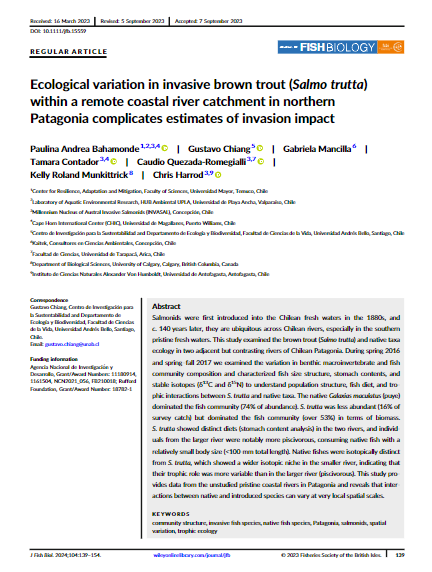Ecological variation in invasive brown trout (Salmo trutta) within a remote coastal river catchment in northern Patagonia complicates estimates of invasion impact

Fecha
2023-10Autor
Bahamonde, Paulina Andrea [Univ Mayor, Fac Sci, Ctr Resilience Adaptat & Mitigat, Temuco, Chile]
Chiang, Gustavo
Mancilla, Gabriela
Contador, Tamara
Quezada-Romegialli, Caudio
Munkittrick, Kelly Roland
Harrod, Chris
Ubicación geográfica
Notas
HERRAMIENTAS
Acceda a títulos restringidos
¿Cómo descargar?Resumen
Salmonids were first introduced into the Chilean fresh waters in the 1880s, and c. 140 years later, they are ubiquitous across Chilean rivers, especially in the southern pristine fresh waters. This study examined the brown trout (Salmo trutta) and native taxa ecology in two adjacent but contrasting rivers of Chilean Patagonia. During spring 2016 and spring-fall 2017 we examined the variation in benthic macroinvertebrate and fish community composition and characterized fish size structure, stomach contents, and stable isotopes (delta 13C and delta 15N) to understand population structure, fish diet, and trophic interactions between S. trutta and native taxa. The native Galaxias maculatus (puye) dominated the fish community (74% of abundance). S. trutta was less abundant (16% of survey catch) but dominated the fish community (over 53%) in terms of biomass. S. trutta showed distinct diets (stomach content analysis) in the two rivers, and individuals from the larger river were notably more piscivorous, consuming native fish with a relatively small body size (<100-mm total length). Native fishes were isotopically distinct from S. trutta, which showed a wider isotopic niche in the smaller river, indicating that their trophic role was more variable than in the larger river (piscivorous). This study provides data from the unstudied pristine coastal rivers in Patagonia and reveals that interactions between native and introduced species can vary at very local spatial scales.
URI
https://repositorio.umayor.cl/xmlui/handle/sibum/9424https://onlinelibrary-wiley-com.bibliotecadigital.umayor.cl:2443/doi/epdf/10.1111/jfb.15559
https://doi.org/10.1111/jfb.15559
Coleccion/es a la/s que pertenece:
Si usted es autor(a) de este documento y NO desea que su publicación tenga acceso público en este repositorio, por favor complete el formulario aquí.